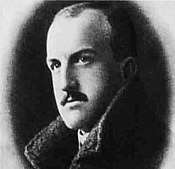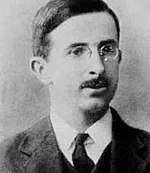Fenerbahçe S.K. (football)
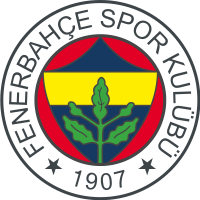 | ||||
| Full name | Fenerbahçe Spor Kulübü | |||
|---|---|---|---|---|
| Nickname(s) |
Sarı Kanaryalar (The Yellow Canaries) Sarı Lacivertliler (The Yellow-Navy Blues) Efsane (The Legend) Fener | |||
| Short name | FB | |||
| Founded |
3 May 1907 as Fenerbahçe Futbol Kulübü[lower-alpha 1] in Kadıköy, Istanbul, Turkey | |||
| Ground | Şükrü Saracoğlu Stadium | |||
| Capacity | 47,834 (all-seater)[1] | |||
| Chairman | Ali Koç | |||
| Manager | Phillip Cocu | |||
| League | Süper Lig | |||
| 2017–18 | Süper Lig, 2nd | |||
| Website | Club website | |||
|
| ||||
| Active departments of Fenerbahçe | ||
|---|---|---|
| Football | Basketball (Men's) | Basketball (Women's) |
| Volleyball (Men's) | Volleyball (Women's) | Table Tennis |
| Swimming | Rowing | Sailing |
| Athletics | Boxing | eSports |
Fenerbahçe Spor Kulübü (Turkish pronunciation: [feˈnæɾbaht͡ʃe], Fenerbahçe Sports Club), commonly known as Fenerbahçe, are a Turkish football club based in Istanbul, Turkey. The club's name comes from Fenerbahçe neighbourhood of Istanbul. The professional football department is the most notable one of Fenerbahçe SK, a major multi-sport club who compete in football, basketball, volleyball, athletics, swimming, sailing, rowing, boxing, and table tennis, among others, with many major honours won in each department. Fenerbahçe are one of the most successful and best supported football teams in Turkey, having never been relegated to lower divisions, and currently compete in the Turkish Super League and the Turkish Cup. They are nicknamed Sarı Kanaryalar (Turkish for "Yellow Canaries") and play their home games at Şükrü Saracoğlu Stadium, their own traditional home ground in Kadıköy, Istanbul.
Fenerbahçe have won 19 Turkish Super League titles, 6 Turkish Cups and 9 Turkish Super Cups, among others.[2] With 28 Turkish championships in total (19 Super League, 6 National Division, and 3 former Turkish Football Championship titles) Fenerbahçe hold the record for most national championship titles won.[3][4] The club are also leading the all-time table of the Turkish Super League. In international club football, Fenerbahçe have won the Balkans Cup in 1968, which is marked as the first ever non-domestic trophy won by a Turkish football club. In UEFA competitions, Fenerbahçe have reached the quarter-finals in the 1963–64 season of the UEFA Cup Winners' Cup and in the 2007–08 season of the UEFA Champions League. The club's semi-final performance in the 2012–13 season of the UEFA Europa League is marked as their greatest achievement in European competitions. Fenerbahçe are a member of the European Club Association.
Fener are one of the best supported Turkish teams and have millions of fans inside Turkey as well as millions of others in the Turkish communities all over the world. The club have a long-standing rivalry with other major Istanbul clubs, namely with Beşiktaş and Galatasaray. The Intercontinental Derby between Fenerbahçe and Galatasaray is considered to be one of the fiercest and most intense derbies in the world.[5][6] In September 2009, British Daily Mail ranked the Fenerbahçe – Galatasaray derby second among the ten greatest football rivalries of all-time.[7] Its name derives from the fact that the clubs are located on the Asian (Fenerbahçe) and European (Galatasaray) sides of the Bosphorus strait in Istanbul.
History
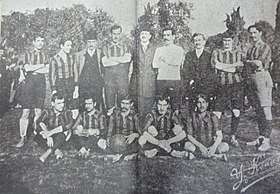
Early years 1907–1959
Fenerbahçe was founded in 1907 in Kadıköy, Istanbul, by local men Ziya Songülen, Ayetullah Bey, and Necip Okaner. This group of men founded the club secretly in order to keep a low profile and not get into any trouble with the strict Ottoman rule, so strict that the Sultan Abdul Hamid II forbade the Turkish youth to set up a club or engage in the game of football played by the English families that was watched in envy. The three men came together and concluded that Kadıköy was in desperate need of its own football club, where locals would get a chance to practise the game of football. Ziya Songülen was elected the first president of the club, Ayetullah Bey became the first general secretary and Necip Okaner was given the post of general captain.[8] The lighthouse situated on the Fenerbahçe cape was a big influence on the design of the club's first crest, which sported the yellow and white colors of daffodils around the lighthouse. The kits were also designed with yellow and white stripes.[8] The crest of the club was changed in 1910 when Hikmet Topuzer redesigned the badge after Ziya Songülen had changed the colors to yellow and navy, still seen today. Fenerbahçe's activities were kept in secrecy until a legislation reform in 1908, when, under a new law, all football clubs had to register to exist legally.[8]
The founding line-up included Ziya Songülen, Ayetullah Bey, Necip Okaner, Galip Kulaksızoğlu, Hassan Sami Kocamemi, Asaf Beşpınar, Enver Yetiker, Şevkati Hulusi Bey, Fuat Hüsnü Kayacan, Hamit Hüsnü Kayacan, and Nasuhi Baydar.[9]
Struggling with financial difficulties, Fenerbahçe joined the Istanbul Football League in 1909, finishing fifth in their first year. Fenerbahçe won the 1911–12 season of the Istanbul Football League marking this championship as the first success in their long history. Mustafa Elkatipzade introduced other sports to the club realizing that football should not be the only sport being practised; it is due to his efforts that Fenerbahçe Sports Club was born.[10]
Fenerbahçe played against the staff of the Royal Navy that occupied Istanbul during the Turkish War of Independence. Some British soldiers formed football teams that were named after the players' speciality, for example Essex Engineers, Irish Guards, Grenadiers, and Artillery. These teams played against each other and against local football teams in Istanbul. Fenerbahçe won many of these matches.[11] The most known match played against the British was the match that would determine the winner of the General Harrington Cup.
Fenerbahçe won the Istanbul Football Leagues 16 times, the Turkish National Division 6 times, and the Turkish Football Championship 3 times, all of them records, profiling themselves as a forerunner and dominating side in Turkish football before the introduction of the professional nationwide league in 1959.[3]
Winning the first National League
.jpg)
The Turkish Football Federation founded a professional national league in 1959, which continues today under the name of the Süper Lig. Fenerbahçe won the first tournament, beating archrivals Galatasaray 4–1 on aggregate.[12] The next year, Fenerbahçe participated in the European Cup for the first time. They qualified through a 4–3 win over Csepel SC, being the first Turkish club to advance to the next round by eliminating its opponent. They lost their first-round game to Nice 1–5 in a playoff game after drawing on aggregate.[13] Fenerbahçe reached the quarter-final of the 1963–64 European Cup Winners' Cup where it was eliminated by MTK Budapest. Fenerbahçe won four more league titles in the 1960s and were runners-up three times, making it the most successful club of that era.[14][15] Fenerbahçe was coached by Ignác Molnár at the time, a famous Hungarian coach who had introduced a new style of football in Turkey. Under his guidance, Fenerbahçe managed to eliminate English champions Manchester City in the first round of the 1968–69 European Cup.
Balkans Cup victory
In the 1966–67 Balkans Cup (a competition set up for Eastern European clubs from Albania, Bulgaria, Greece, Romania, Turkey and Yugoslavia that existed between the 1960–61 and 1993–94 seasons), Fenerbahçe won the cup after three final matches against Greek club AEK Athens, making them the first Turkish club to win a non-domestic competition. This success would remain unparalleled by a Turkish club until Sarıyer and Samsunspor won the cup many years later in the 1990s, when the competition lost much of its popularity.[16]
Later years
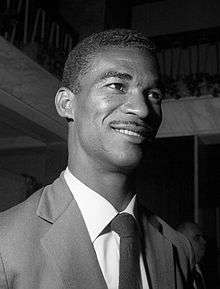
The 1970s saw Fenerbahçe bring in the famous Didi as their new coach. Fenerbahçe won four more league titles, including a double with Cemil Turan being the top goal scorer three times. The 1970s also established a rivalry with Trabzonspor, where for almost a decade Fenerbahçe and Trabzonspor were competing each other for the title. The 1980s saw Fenerbahçe win three more league titles. Under the guidance of Kálmán Mészöly, Fenerbahçe managed to eliminate French champions Bordeaux in the first round of the 1985–86 European Cup. This victory marked a turning point as for almost a decade no Turkish club managed to get past the first round in European competitions.
Galatasaray and Beşiktaş dominated the Turkish League during the 1990s, combining to win nine out of ten titles. Fenerbahçe's only Turkish League success during the 1990s came in the 1995–96 season under the guidance of Carlos Alberto Parreira.[14][15] In the 1996–97 UEFA Champions League season, Fenerbahçe completed the group stage with seven points[17] and, amongst others, beat Manchester United 1–0 at Old Trafford, undoing the record of the English giants being unbeaten for 40 years in their homeground.
Fenerbahçe won the league title in 2001, denying Galatasaray a fifth consecutive title. It followed up the next season with a second-place behind Galatasaray with new coach Werner Lorant. The next season, however, did not go so well: Fenerbahçe finished in sixth place.[18] Despite this, that season is memorable to many Fenerbahçe fans due to a 6–0 win against arch-rivals Galatasaray at the Şükrü Saracoğlu Stadium on 6 November 2002.[19] After firing Werner Lorant, the club hired another German coach in, Christoph Daum. Daum had previously coached in Turkey, winning the league with Beşiktaş in 1994–95. Fenerbahçe brought in players including Pierre van Hooijdonk, Mehmet Aurélio and Fabio Luciano as a rebuilding process. These new players lead Fenerbahçe to its 15th title and third star (one being awarded for every five league titles won by a club).[20]
The next year was followed by a narrow championship over Trabzonspor, winning a then record 16 Turkish Football League championships.[21] Fenerbahçe lost the title in the last week of the 2005–06 season to Galatasaray. Fenerbahçe needed a win, but instead drew 1–1 with Denizlispor while Galatasaray won 3–0 over Kayserispor. Soon after, Christoph Daum resigned as manager[22] and was replaced by Zico on 4 July 2006.[23][24] Zico began his reign by signing two new defenders: highly touted Uruguayan international Diego Lugano and Zico's fellow Brazilian Edu Dracena.[25] Zico also signed two strikers in Serbian international Mateja Kežman and another Brazilian, Deivid.[26] Fenerbahçe's 2006–07 domestic season started with a 6–0 win over relegation candidates Kayseri Erciyesspor.[27] In the 32nd week of the Süper Lig, Fenerbahçe drew Trabzonspor 2–2, while Beşiktaş lost to Bursaspor 0–3, putting the former out of contention for the title.[28][29] Fenerbahçe won its 17th Süper Lig title in 2006–07.[30]
2007–present



On 11 January 2007, Fenerbahçe were officially invited to G-14.[31] G-14 was an association which consists of top European clubs. Fenerbahçe are the only Turkish club that have been invited to this association. In March 2008, Fenerbahçe's record application was accepted by Guinness World Records Menagement Team, which envisages Fenerbahçe to have the most medal and trophy achievements in the world with its nine branches entirely, a total of 1,134 cups and medals.[32]
Under Zico's command, Fenerbahçe qualified from the 2007–08 Champions League group stage for the first time in the club's history and went on to beat Sevilla to become a quarter-finalist in the 2007–08 season. Zico is also the most successful manager of the team's history in the Champions League. After successful scores both in the Turkish league and international matches, Zico gained a new nickname from the Fenerbahçe fans: Kral Arthur (meaning "King Arthur" in Turkish). In February 2009, Fenerbahçe became the first Turkish club to enter the Deloitte Football Money League.[33] Since 2000, Fenerbahçe improved the club's finances and facilities, bringing world stars to the club such as Ariel Ortega, Pierre van Hooijdonk, Alex, Stephen Appiah, Nicolas Anelka and, more recently, Mateja Kežman, Roberto Carlos, Daniel Güiza, Dirk Kuyt, Diego Ribas, Nani, and Robin van Persie.
In the 2009–10 season Fenerbahçe lost the title on the last matchday; Fenerbahçe players were told that a draw would be enough towards the end of the match only to find out that the other critical game went against their favour, as Bursaspor beat Beşiktaş 2–1 to win the title. Despite the title loss, Fenerbahçe ended the season with the most clean sheets (10), as well as the joint longest winning streak (8).[34] In July 2011, Fenerbahçe fans invaded the pitch during a friendly against the Ukrainian champions Shakhtar Donetsk. As punishment, Fenerbahçe were sentenced to two Süper Lig games in an empty stadium. The TFF later allowed those two games to be filled with spectators; men were barred, while women and children under 12 were admitted for free.[35] On 29 October 2012, Antalyaspor ended Fenerbahçe’s 47-match unbeaten run in the Süper Lig at the Şükrü Saracoğlu Stadium. Fenerbahçe had not lost a match at home since they were beaten 2–3 by eventual champions Bursaspor in week 22, on 22 February 2010. Fenerbahçe won 38 and drew nine in the 47 matches they played within 980 days since 22 February 2010.[36] On 3 November 2012, Fenerbahçe peck Akhisar Belediyespor to break a 181-day away jinx.[37] On 2 May 2013, Fenerbahçe were eliminated by Benfica 3–2 on aggregate in the semi-final of the 2012–13 Europa League, one of the biggest successes in Fenerbahçe's history in UEFA competitions.[38][39]
On 28 June 2013, Ersun Yanal agreed to take charge of Fenerbahçe to replace Aykut Kocaman, who resigned in late May.[40][41] Ersun Yanal's appointment coincided with tough times for Fenerbahçe, which had just been banned from European competitions for two seasons over their alleged involvement in a domestic sports corruption scandal. Fenerbahçe, which finished second in the Süper Lig in 2012–13, thus missed-out on the 2013–14 Champions League, which it had been due to enter in the third qualifying round.[42][43] Fenerbahçe finished the 2014–15 season as runners-up, forcing the board of directors to undertake some major changes. For the 2015–16 season, Fenerbahçe brought in Vítor Pereira as their new coach. Portuguese star Nani, Danish defender Simon Kjær and Robin van Persie were added to the squad to fulfill the club's ambitions to be successful in the Süper Lig and European competitions. On 10 December 2015, Fenerbahçe played their 200th European game against Celtic.
Former players

When it was first founded in 1907, Fenerbahçe had a large squad. One of these players, Galip Kulaksızoğlu, was the longest serving player of the original squad, spending 17 years at the club, retiring in 1924 after 216 matches.[44] Zeki Rıza Sporel and Bekir Refet, the first Tukish footballer ever to play abroad, were among the first products of the Fenerbahçe youth system. During his 18-year career with the club, Zeki Rıza scored 470 goals in 352 matches, or 1.3 goals every match, making him the all-time top scorer of Fenerbahçe.[44] Zeki Rıza was also capped for the national team 16 times, scoring 15 goals. Cihat Arman became the first in a long-line of long-serving goalkeepers, playing 12 seasons and in 308 matches with the club.[44] Lefter Küçükandonyadis was one of the first Turkish football players to play in Europe. Lefter spent two seasons in Europe, playing for Fiorentina and Nice before returning to Fenerbahçe. All in all, Lefter scored 423 goals in 615 matches for the club, helping them to two Istanbul Football League titles and three Turkish League titles.
Another notable player, Can Bartu, became the next big Turkish export to Europe. He was also the first Turkish football player to play in a European competition final, doing so with Fiorentina against Atlético Madrid in 1962. Can also spent some seasons playing for Venezia and Lazio before returning to Fenerbahçe in 1967. He was a four-time league champion with Fenerbahçe and scored 162 goals in 330 matches. Some of the other greatest Turkish players who played for Fenerbahçe include: Fikret Arıcan, Fikret Kırcan, Halit Deringör, Melih Kotanca, Burhan Sargun, Nedim Doğan, Cemil Turan, Selçuk Yula, Müjdat Yetkiner, Oğuz Çetin, Aykut Kocaman, Rüştü Reçber, and Tuncay Şanlı.
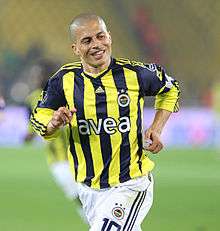
Former Romania goalkeeper Ilie Datcu was the first foreigner to reach 100 caps for Fenerbahçe. In recent decades, Fenerbahçe have gained an influx of foreigners who have helped the club to 19 Süper Lig titles. Among these include Uche Okechukwu, who after 13 seasons with Fenerbahçe and İstanbulspor became the longest serving foreigner in Turkey. During Uche's career with Fenerbahçe, he won two league titles and became a fan favourite. More recently, Fenerbahçe have been the home to Brazilian-born Mehmet Aurélio who, in 2006, became the first naturalized Turkish citizen to play for the Turkish national team.
Alex is another Brazilian player who scored the most goals of all foreign players who have played for Fenerbahçe. He managed to become top scorer of the Turkish Süper Lig on two occasions (in 2006–07 and 2010–11), Turkish Footballer of the Year twice (in 2005 and 2010), as well as assist leader in the 2007–08 season of the UEFA Champions League.[45] Based on all those achievements, as well as his exemplary character and sportsmanship on and off the field, acknowledged by fans of Fenerbahçe and their rivals alike, he became the most successful and renowned foreign player to have ever played for the club and one of a few whose statue has been erected by the supporters of the club in the Yoğurtçu Park, in the near of Şükrü Saracoğlu Stadium.[46] Some of the other foreign top players who played for Fenerbahçe over the years include: Toni Schumacher (1988–91), Jes Høgh (1995–99), Jay-Jay Okocha (1996–98), Elvir Bolić (1995–2000), Kennet Andersson (2000–02), Ariel Ortega (2002–03), Pierre van Hooijdonk (2003–05), Nicolas Anelka (2005–06), Stephen Appiah (2005–08), Mateja Kežman (2006–09), Diego Lugano (2006–11), Roberto Carlos (2007–09), Dirk Kuyt (2012–15), and Nani (2015–16).
Support
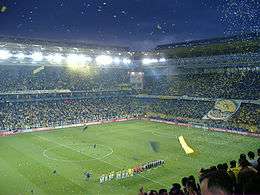
Fenerbahçe have developed a strong following since their foundation in 1907. They are one of the most popular clubs in Turkey, with about 35% of the fans supporting them, and the most popular in Istanbul and Ankara.[47] They have a large fanbase throughout the country, in Northern Cyprus, Azerbaijan, and in the Turkish diaspora.[48] The supporters are known for their passionate, fierce, and unwavering support. Since the rebuilding of the Şükrü Saracoğlu Stadium, Fenerbahçe's average attendances have been among the highest in Turkey.[49]
Fenerbahçe have several supporter organisations, including Genç Fenerbahçeliler (GFB), Kill For You (KFY), Antu/Fenerlist, EuroFeb (Fenerbahçe supporters in Europe), Group CK (Cefakâr Kanaryalar), 1907 ÜNİFEB, Vamos Bien, and SUADFEB. Many fanzines, blogs, podcasts, forums and fan websites have been dedicated to the club.
Relationships with other clubs
More recently, in November 2011 Fenerbahçe's Genç Fenerbahçeliler created a friendly relationship with Torcida Sandžak, the organized supporters of Serbian club Novi Pazar. During a Süper Lig match against İstanbul Büyükşehir Belediyespor at the Şükrü Saraçoğlu Stadium, the Genç Fenerbahçeliler and 1907 Gençlik stand deployed a giant banner reading "Kalbimiz Seninle Novi Pazar" ("Novi Pazar, Our Hearts Are With You")[50] and after then, in the game against Radnicki Kragujevac in the Serbian SuperLiga, Torcida Sandžak members deployed a giant banner reading "Sancak'ta atıyor, Fenerbahçe'nin kalbi" ("The heart of Fenerbahçe beats in Sandžak").[51] On 2 March 2012, Fenerbahçe's Genç Fenerbahçeliler and 1907 Gençlik members were invited to Novi Pazar for the match against Partizan in the Serbian SuperLiga. Thousands of Torcida Sandžak members welcomed Genç Fenerbahçeliler and 1907 Gençlik's 17 members.[52]
Rivalries
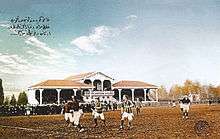
"The big three" clubs of Istanbul, Beşiktaş, Galatasaray and Fenerbahçe, have a century-long history of rivalry. The Fenerbahçe–Galatasaray rivalry is the primary Istanbul derby and the most important rivalry in Turkish football; matches between the two teams are known as The Intercontinental Derby (Turkish: Kıtalararası Derbi). The rivalry started on 23 February 1934, when a friendly game between both clubs turned into a riot, forcing the match to be abandoned. The rivalry has led to violence among supporters on numerous occasions.[53] Torches, smoke, flags, and giant posters are used to create visual grandeur and apply psychological pressure on visiting teams, which fans call "welcoming them to hell".
Stadium
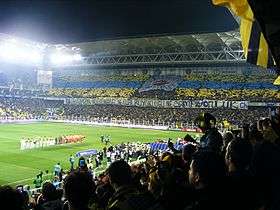
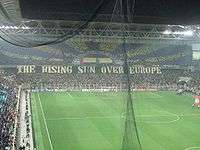
Fenerbahçe play their home matches at the Şükrü Saracoğlu Stadium,[54] their own traditional home ground in the Kadıköy district of Istanbul, since 1908. Most recently renovated between 1999 and 2006, its capacity is 50,509.[55] Unusually for a Turkish football stadium, there is no running track around the perimeter of the pitch. The club's museum has been situated in the stadium since 2005, after having been housed at a variety of locations.[56] Before Şükrü Saracoğlu Stadium was built, the field was known as Papazın Çayırı ("The field of the priest"). The field, however, became the very first football pitch of Turkey, where the first league games of the Istanbul Football League were all held successively. In 1908, local teams of the league needed a regular football field, so this land was leased from the Ottoman Sultan Abdul Hamid II for 30 Ottoman gold pounds a year. The total construction cost was 3,000 Ottoman gold pounds. The name was changed to the Union Club Field after the club which made the highest donation for the construction.
The Union Club Field was used by many teams in İstanbul, including the owner, Union Club (which changed its name to İttihatspor after World War I), Fenerbahçe, Galatasaray, and Beşiktaş. However, it had lost its importance when a bigger venue, the Taksim Stadium, was built in 1922, inside the courtyard of the historic Taksim Topçu Kışlası (Taksim Artillery Barracks), which was located at the present-day Taksim Gezi Parkı (Taksim Park). İttihatspor (which had close relations with the political İttihat ve Terakki), was forced to sell it to the state, in which Şükrü Saracoğlu was a member of the CHP government. Thus, the ownership of the stadium passed to the state, but the field was immediately leased to Fenerbahçe.
Later, on 27 May 1933, Fenerbahçe purchased the stadium from the government when Şükrü Saracoğlu was the president of Fenerbahçe, for either the symbolic amount of 1 TL or the worth of the stadium which was 9,000 TL. The name of the field was changed to Fenerbahçe Stadium, and this made Fenerbahçe the first football club in Turkey to own its stadium, with the help of the government. In the following years, Fenerbahçe renovated the stadium and increased its seating capacity. By 1949, Fenerbahçe Stadium was the largest football venue in Turkey, with a seating capacity of 25,000. The name of the stadium was changed once more in 1998, becoming Fenerbahçe Şükrü Saracoğlu Stadium, named after Fenerbahçe's president and Turkey's fifth Prime Minister, Şükrü Saracoğlu. In 1999, the latest round of renovations and capacity increasing projects started. The tribunes on the four sides of the stadium were torn down one at a time, as the Turkish Super League seasons progressed, and the entire renewal and construction project was finalised in 2006, with the efforts of Fenerbahçe president Aziz Yıldırım and the team's board of directors.

Şükrü Saracoğlu
Mehmet Şükrü Saracoğlu was a Turkish politician and the fifth Prime Minister of Turkey. He was born in Ödemiş in 1887. Saracoğlu progressed as being a teacher before graduating from foreign faculties. He also became the Minister of Education in 1924. Saracoğlu was successful at every area even in politics and was a statesman in Turkey. He was also a keen Fenerbahçe supporter and became the president of the club from 1934 to 1950, which made him the longest serving Fenerbahçe president. In 1953, three years after retiring from politics, he died in Istanbul on 27 December.[57]
Club crest and colours
Since the club's foundation, Fenerbahçe have used the same badge, which has only undergone minor alterations. It was designed by Hikmet Topuzer, nicknamed Topuz Hikmet, who played as a left winger, in 1910, and had made as lapel pins by Tevfik Haccar Taşçı in London. The crest consists of five colours. The white section which includes the writing Fenerbahçe Spor Kulübü ★ 1907 ★ represents purity and open-heartedness, the red section represents love and attachment to the club and symbolises the Turkish flag. The yellow section symbolises other ones' envy and jealousy about Fenerbahçe, while the navy symbolises nobility. The oak leaf which rises from the navy and yellow section shows the force and the power of being a member of Fenerbahçe. The green colour of the leaf shows that the success of Fenerbahçe is imperative.[58] Hikmet Topuzer describes the story of the emblem as below:
| “ | After the change of the club’s colours from yellow and white to yellow and navy, it was an issue to create an emblem with our new colours. My friends left the design of this emblem to me. Firstly, I brought together the colours of our national flag, red and white. Then drew a heart shape over the red and gave it a yellow and navy colour, adding an acorn leaf that represents resistance, power and strength. I wrote the club name and foundation date on the white section. When drawing our emblem, I tried to give this meaning: Serving the club with dependence from heart. The design was favored by my friends and our new emblem was made through the guidance of Tevfik Haccar, who was in Germany at time. After the new alphabet was approved, the design was protected, but the club name on the emblem was changed to Fenerbahçe Spor Kulübü ★ 1907 ★.[58] | ” |
Honours
Domestic competitions
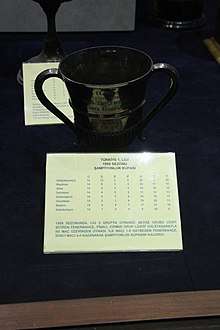
National Championships – 28 (record)
- Winners (19): 1959, 1960–61, 1963–64, 1964–65, 1967–68, 1969–70, 1973–74, 1974–75, 1977–78, 1982–83, 1984–85, 1988–89, 1995–96, 2000–01, 2003–04, 2004–05, 2006–07, 2010–11, 2013–14
- Runners-up (22): 1959–60, 1961–62, 1966–67, 1970–71, 1972–73, 1975–76, 1976–77, 1979–80, 1983–84, 1989–90, 1991–92, 1993–94, 1997–98, 2001–02, 2005–06, 2007–08, 2009–10, 2011–12, 2012–13, 2014–15, 2015–16, 2017–18
National Cups
- Winners (6): 1967–68, 1973–74, 1978–79, 1982–83, 2011–12, 2012–13
- Runners-up (11): 1962–63, 1964–65, 1988–89, 1995–96, 2000–01, 2004–05, 2005–06, 2008–09, 2009–10, 2015–16, 2017–18
- Winners (9): 1968, 1973, 1975, 1984, 1985, 1990, 2007, 2009, 2014
- Runners-up (9): 1970, 1974, 1978, 1979, 1983, 1989, 1996, 2012, 2013
- Winners (8) (record): 1945, 1946, 1950, 1973, 1980, 1989, 1993, 1998
- Runners-up (7): 1944, 1971, 1976, 1977, 1992, 1994, 1995
- Winners (2) (record): 1964, 1998
European competitions
- Winners (1): 1966–67
Regional competitions

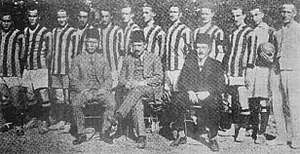
- Winners (16) (record): 1911–12, 1913–14, 1914–15, 1920–21, 1922–23, 1929–30, 1932–33, 1934–35, 1935–36, 1936–37, 1943–44, 1946–47, 1947–48, 1952–53, 1956–57, 1958–59
- Winners (1): 1945
- Winners (4) (record): 1930, 1934, 1938, 1939
Others
- Winners (1): 1923
- Winners (4) (record): 1982, 1983, 1984, 1985
- Winners (12) (shared-record): 1969, 1973, 1975, 1976, 1978, 1979, 1980, 1982, 1985, 1986, 1994, 1995
- Winners (2) (record): 1976, 1980
- Winners (1): 1967
European Record
Best achievements
- As of 17 August 2017
| Season | Achievement | Notes | |
|---|---|---|---|
| UEFA Cup Winners' Cup | |||
| 1963–64 | Quarter-Finalist | eliminated by | |
| UEFA Champions League | |||
| 2007–08 | Quarter-Finalist | eliminated by | |
| UEFA Europa League | |||
| 2012–13 | Semi-Finalist | eliminated by | |
Statistics
- As of 14 August 2018
| Competition | Pld | W | D | L | GF | GA | GD |
|---|---|---|---|---|---|---|---|
| UEFA Champions League | 105 | 32 | 20 | 53 | 119 | 177 | –58 |
| UEFA Europa League | 108 | 46 | 25 | 37 | 145 | 140 | +5 |
| UEFA Cup Winners' Cup | 9 | 3 | 1 | 5 | 11 | 11 | 0 |
| TOTAL | 222 | 81 | 46 | 95 | 275 | 328 | –53 |
UEFA ranking
- As of 24 September 2018[60]
| Rank | Country | Team | Points |
|---|---|---|---|
| 54 | Dnipro Dnipropetrovsk | 24.000 | |
| 55 | Fenerbahçe | 23.500 | |
| 56 | FC Steaua Bucharest | 23.000 |
Players
Current squad
As of 31 August 2018[61] Note: Flags indicate national team as defined under FIFA eligibility rules. Players may hold more than one non-FIFA nationality.
|
|
Out on loan
Note: Flags indicate national team as defined under FIFA eligibility rules. Players may hold more than one non-FIFA nationality.
|
Fenerbahçe A2
- Main article: Fenerbahçe S.K. A2[62]
Academy teams
Retired number(s)
12
Team captains
Player records
Most goals
| Outline | Player | Record |
|---|---|---|
| Most goals in all-time | 470 | |
| Most goals in Süper Lig | 140 | |
| Most goals in one match | 8 | |
| Most goals in one league match | 6 | |
| Most goals in UEFA competitions | 15 |
Note: Zeki Rıza Sporel scored his record eight goals against Anadolu in 1931, Melih Kotanca repeated this record against Topkapı in 1940. Tanju Çolak scored six goals against Karşıyaka in the 1992–93 season.
Most appearances
| Outline | Player | Record |
|---|---|---|
| Most appearances in all-time | 763 | |
| Most appearances in UEFA competitions | 86 |
Past seasons
| Domestic results since 1959 | ||||||||||
|---|---|---|---|---|---|---|---|---|---|---|
| Season | Place | G | W | D | L | GS | GA | Pts | Turkish Cup | |
| 1959 | 1 | 16 | 13 | 2 | 1 | 33 | 8 | 26 | ||
| 1959–60 | 2 | 38 | 27 | 6 | 5 | 88 | 38 | 60 | ||
| 1960–61 | 1 | 38 | 26 | 9 | 3 | 81 | 29 | 61 | ||
| 1961–62 | 2 | 38 | 23 | 7 | 8 | 64 | 30 | 53 | ||
| 1962–63 | 3 | 42 | 24 | 12 | 6 | 73 | 28 | 60 | Runners-Up | |
| 1963–64 | 1 | 34 | 21 | 11 | 2 | 55 | 14 | 53 | ||
| 1964–65 | 1 | 30 | 18 | 11 | 1 | 52 | 13 | 47 | Runners-Up | |
| 1965–66 | 4 | 30 | 10 | 12 | 8 | 32 | 25 | 32 | Semi-finals | |
| 1966–67 | 2 | 32 | 17 | 9 | 6 | 37 | 20 | 43 | Quarter-finals | |
| 1967–68 | 1 | 32 | 19 | 11 | 2 | 38 | 12 | 49 | Winners | |
| 1968–69 | 4 | 30 | 13 | 9 | 8 | 34 | 25 | 35 | ||
| 1969–70 | 1 | 30 | 17 | 10 | 3 | 31 | 6 | 44 | ||
| 1970–71 | 2 | 30 | 14 | 13 | 3 | 43 | 23 | 41 | ||
| 1971–72 | 3 | 30 | 14 | 11 | 5 | 37 | 21 | 39 | ||
| 1972–73 | 2 | 30 | 16 | 10 | 4 | 42 | 17 | 42 | ||
| 1973–74 | 1 | 30 | 15 | 13 | 2 | 39 | 15 | 43 | Winners | |
| 1974–75 | 1 | 30 | 15 | 13 | 2 | 43 | 18 | 43 | ||
| 1975–76 | 2 | 30 | 14 | 12 | 4 | 40 | 18 | 40 | ||
| 1976–77 | 2 | 30 | 12 | 15 | 3 | 31 | 17 | 39 | ||
| 1977–78 | 1 | 30 | 17 | 8 | 5 | 48 | 24 | 42 | ||
| 1978–79 | 3 | 30 | 15 | 8 | 7 | 41 | 23 | 38 | Winners | |
| 1979–80 | 2 | 30 | 12 | 11 | 7 | 31 | 27 | 35 | ||
| 1980–81 | 10 | 30 | 9 | 11 | 10 | 31 | 27 | 29 | ||
| 1981–82 | 3 | 32 | 15 | 11 | 6 | 48 | 26 | 41 | Quarter-finals | |
| 1982–83 | 1 | 34 | 18 | 13 | 3 | 43 | 20 | 49 | Winners | |
| 1983–84 | 2 | 34 | 17 | 11 | 6 | 46 | 24 | 45 | ||
| 1984–85 | 1 | 34 | 18 | 14 | 2 | 65 | 25 | 50 | ||
| 1985–86 | 5 | 36 | 13 | 16 | 7 | 40 | 32 | 42 | ||
| 1986–87 | 5 | 36 | 13 | 13 | 10 | 46 | 39 | 39 | ||
| 1987–88 | 8 | 38 | 15 | 10 | 13 | 45 | 43 | 55 | ||
| 1988–89 | 1 | 36 | 29 | 6 | 1 | 103 | 27 | 93 | Runners-Up | |
| 1989–90 | 2 | 34 | 22 | 4 | 8 | 70 | 38 | 70 | ||
| 1990–91 | 5 | 30 | 12 | 8 | 10 | 53 | 53 | 44 | ||
| 1991–92 | 2 | 30 | 23 | 2 | 5 | 81 | 35 | 71 | ||
| 1992–93 | 5 | 30 | 18 | 4 | 8 | 75 | 41 | 58 | Semi-finals | |
| 1993–94 | 2 | 30 | 21 | 6 | 3 | 69 | 26 | 69 | Quarter-finals | |
| 1994–95 | 4 | 34 | 20 | 7 | 7 | 78 | 35 | 67 | Semi-finals | |
| 1995–96 | 1 | 34 | 26 | 6 | 2 | 68 | 19 | 84 | Runners-Up | |
| 1996–97 | 3 | 34 | 22 | 7 | 5 | 79 | 25 | 73 | Quarter-finals | |
| 1997–98 | 2 | 34 | 21 | 8 | 5 | 61 | 25 | 71 | Quarter-finals | |
| 1998–99 | 3 | 34 | 22 | 6 | 6 | 84 | 29 | 72 | ||
| 1999–00 | 4 | 34 | 17 | 10 | 7 | 59 | 44 | 61 | Last 32 | |
| 2000–01 | 1 | 34 | 24 | 4 | 6 | 82 | 39 | 76 | Runners-Up | |
| 2001–02 | 2 | 34 | 24 | 3 | 7 | 70 | 31 | 75 | 4th Round | |
| 2002–03 | 6 | 34 | 13 | 12 | 9 | 55 | 42 | 31 | 2nd Round | |
| 2003–04 | 1 | 34 | 23 | 7 | 4 | 82 | 41 | 76 | Semi-Finals | |
| 2004–05 | 1 | 34 | 26 | 2 | 6 | 77 | 24 | 80 | Runners-Up | |
| 2005–06 | 2 | 34 | 25 | 6 | 3 | 90 | 34 | 81 | Runners-Up | |
| 2006–07 | 1 | 34 | 20 | 10 | 4 | 65 | 21 | 70 | Semi-Finals | |
| 2007–08 | 2 | 34 | 22 | 7 | 5 | 72 | 37 | 73 | Quarter-Finals | |
| 2008–09 | 4 | 34 | 18 | 7 | 9 | 60 | 36 | 61 | Runners-Up | |
| 2009–10 | 2 | 34 | 23 | 5 | 6 | 61 | 28 | 74 | Runners-Up | |
| 2010–11 | 1 | 34 | 26 | 4 | 4 | 84 | 34 | 82 | Group stage | |
| 2011–12 | 2 | 34 | 20 | 8 | 6 | 61 | 34 | 68 | Winners | |
| 2012–13 | 2 | 34 | 18 | 7 | 9 | 56 | 39 | 61 | Winners | |
| 2013–14 | 1 | 34 | 23 | 5 | 6 | 74 | 33 | 74 | Fourth Round | |
| 2014–15 | 2 | 34 | 22 | 8 | 4 | 60 | 29 | 74 | Semi-Finals | |
| 2015–16 | 2 | 34 | 22 | 8 | 4 | 60 | 27 | 74 | Runners-Up | |
| 2016–17 | 3 | 34 | 18 | 10 | 6 | 60 | 28 | 64 | Runners-Up | |
| 2017–18 | 2 | 34 | 21 | 9 | 4 | 78 | 36 | 72 | Runners-Up | |
Records
Most
| Outline | Record | Year |
|---|---|---|
| Most wins | 29 | 1988–89 |
| Most draws | 16 | 1985–86 |
| Most defeats | 13 | 1987–88 |
| Most wins in a row | 12 | 2005–06 |
| Most defeats in a row | 3 | 1966–67, 1980–81, 1987–88, 1992–93, 2018–19 |
| Most goals scored | 103 | 1988–89 |
| Most goals conceded | 53 | 1990–91 |
| Highest number of points in any half of a season | 49/51 | 2010–11 |
Fewest
| Outline | Record | Year |
|---|---|---|
| Fewest wins | 9 | 1980–81 |
| Fewest draws | 2 | 1959, 1991–92, 2004–05 |
| Fewest defeats | 1 | 1959, 1963–64, 1988–89 |
| Fewest goals scored | 31 | 1969–70, 1976–77, 1979–80 |
| Fewest goals conceded | 6 | 1969–70 |
Trivia
- Fenerbahçe went through the 1922–23 season of the Istanbul Football League undefeated without conceding a single goal.
- First Turkish club to win a non-domestic trophy (Balkans Cup in 1968)[63]
- All-time best in Turkish League cumulative standings with the highest number of wins and the least losses as well as the most scoring football team in history.[64]
- Best winning percentage in a season:
- 29 wins and 6 draws in 36 matches, 0.888 in the 1988–89 season
- Best group stage finish for a Turkish club in the Europa League:
- 15 points in 6 games against



Club officials
Board members
| Position | Name |
|---|---|
| President | |
| Board Member | |
| Board Member | |
| Board Member | |
| Board Member | |
| Board Member | |
| Board Member | |
| Board Member | |
| Board Member | |
| Board Member | |
| Board Member | |
| Board Member | |
| Board Member | |
| Board Member | |
| Board Member |
Source:[65]
Technical staff
| Position | Name |
|---|---|
| Director of Football | |
| Administrative Manager | |
| Manager | |
| Assistant Manager | |
| Assistant Manager | |
| Goalkeeping Coach | |
| Coach | |
| Coach | |
| Coach | |
| Individual Player Coach | |
| Individual Player Coach | |
| Analyst | |
| Doctor | |
| Physiotherapist | |
| Physiotherapist | |
| Physiotherapist | |
| Masseur | |
| Masseur | |
| Masseur |
Source:[66]
Shirt sponsors and manufacturers
| Period | Kit manufacturers | Shirt sponsors |
|---|---|---|
| 1977–1978 | none | Pereja |
| 1978–1980 | none | |
| 1980–1982 | Banker Kastelli | |
| 1982–1983 | Hisar Bank | |
| 1983–1984 | İstanbul Bankası | |
| 1984–1985 | Adidas | Türk Bank |
| 1985–1987 | Güner | |
| 1987–1988 | Tamek | |
| 1988–1989 | Adidas | Emlak Bankası |
| 1989–1996 | Emlak Bankası | |
| 1996–1997 | VakıfBank | |
| 1997–1998 | Emlak Bankası | |
| 1998–1999 | Rifle/Proton 5x5 | |
| 1999–2000 | Proton 5x5 | |
| 2000–2002 | Fenerium | Telsim |
| 2002–2004 | Aria | |
| 2004–2012 | Adidas | Avea |
| 2012–2014 | Türk Telekom | |
| 2014–2015 | none | |
| 2015–2016 | Yandex/Turkish Airlines1 | |
| 2016–2017 | Nesine.com/Borajet Airlines1 | |
| 2018– | Acıbadem |
1 European Shirt sponsor
Fenerbahçe as a company
Fenerbahçe Futbol A.Ş. is a listed company in Borsa Istanbul as BİST: FENER; Fenerbahçe Spor Kulübü owns a 67.07% stake. The company had a negative equity of 424,317,388 Turkish lire; total assets of 311,233,179 lire; revenue 317,610,262 lire and a net loss of 181,234,264 in the 2014–15 season.[67] Fenerbahçe S.K. entered a settlement agreement with UEFA for breaching UEFA Financial Fair Play Regulations (FFP) on 20 May 2016.[68] The club was required to have an aggregate break-even in 2019 (2016–17, 2017–18 and 2018–19 season), and more specifically a maximum annual net loss of €30 million, €20 million and €10 million in 2015–16, 2016–17 and 2017–18 seasons. Turkish clubs Beşiktaş, Kardemir Karabükspor and Trabzonspor (twice) also entered into settlement agreements in 2014, 2015 and 2016, with Bursaspor and Galatasaray being banned from European football in 2015 and 2016 respectively due to breaching overdue payable and the settlement agreement respectively.
See also
Footnotes
- ↑ Although it is known that the club was founded in the spring of 1907, the day and month are unknown. The date of Mustafa Kemal Atatürk's visit to the club is accepted as the foundation date in honor of him.
References
- ↑ "Stat Bilgileri" (in Turkish). Turkish Football Federation. Retrieved 4 March 2018.
- 1 2 "Müzemiz". www.fenerbahce.org (in Turkish). Retrieved 21 November 2017.
- 1 2 3 "Turkey – List of Champions". www.rsssf.com. RSSSF. Retrieved 25 February 2018.
- ↑ "19 değil, 28 şampiyonluk". www.trthaber.com (in Turkish). TRT Haber. Retrieved 26 October 2017.
- ↑ "History of the Istanbul Derby - Fenerbahce vs Galatasaray". www.sportskeeda.com. Retrieved 21 November 2017.
- ↑ "FootballDerbies.com - All you need to know about the world's best football matches. Derby, Local Derby or Rivalry". www.footballderbies.com.
- ↑ "THE LIST: The greatest rivalries in club football, Nos 10–1". Mail Online. Retrieved 25 June 2015.
- 1 2 3 "Tarihçe" (in Turkish). fenerbahce.org. 15 April 2007. Archived from the original on 22 February 2008. Retrieved 7 January 2013.
- ↑ "Tarihçe - 4. Sayfa" (in Turkish). fenerbahce.org. 15 April 2007. Archived from the original on 20 November 2012. Retrieved 7 January 2013.
- ↑ "Tarihçe - 4. Sayfa" (in Turkish). fenerbahce.org. 14 January 2017. Retrieved 7 January 2017.
- ↑ "Müttefik Kuvvetler ile Yapilan Maçlar" (in Turkish). angelfire.com. 14 June 2007. Retrieved 7 January 2013.
- ↑ "1959 Milli Lig". angelfire.com. 17 June 2007. Retrieved 7 January 2013.
- ↑ "European Competitions 1959-60". rsssf.com. 17 June 2007. Retrieved 7 January 2013.
- 1 2 "Archives". turkish-soccer.com. 5 May 2007. Retrieved 7 January 2013.
- 1 2 "SPOR TOTO SÜPER LİG ŞAMPİYONLUKLARI" (in Turkish). tff.org. 10 January 2013. Retrieved 10 January 2013.
- ↑ "BALKAN KUPASI" (in Turkish). turkfutbolu.net. 2 February 2017. Archived from the original on 28 October 2012. Retrieved 2 February 2017.
- ↑ "UEFA Champions League 1996–97 Season". uefa.com. 10 January 2013. Retrieved 10 January 2013.
- ↑ "2002-2003 1.Süper Lig". angelfire.com. 17 June 2007. Retrieved 10 January 2013.
- ↑ "Fenerbahçe 6–0 Galatasaray" (in Turkish). klasikfutbol.blogspot.com. 10 January 2013. Retrieved 10 January 2013.
- ↑ "2003–2004 1.Süper Lig". angelfire.com. 17 June 2007. Retrieved 10 January 2013.
- ↑ "2004–2005 1.Süper Lig". angelfire.com. 17 June 2007. Retrieved 10 January 2013.
- ↑ "Teşekkürlerimizle..." (in Turkish). fenerbahce.org. 16 June 2006. Retrieved 10 January 2013.
- ↑ "Zico signs two-year Fenerbahçe coaching deal". soccernet.espn.go.com. 4 July 2006. Retrieved 10 January 2013.
- ↑ "Yeni Teknik Direktörümüz ZICO" (in Turkish). fenerbahce.org. 4 July 2006. Retrieved 10 January 2013.
- ↑ "Dracena to Fenerbahçe". taipeitimes.com. 28 August 2006. Retrieved 10 January 2013.
- ↑ "Fenerbahçe soccer club signs four-year contract with Mateja Kezman". english.people.com.cn. 29 August 2006. Retrieved 10 January 2013.
- ↑ "Maç Raporu" (in Turkish). ligtv.com.tr. 5 August 2006. Archived from the original on 5 February 2012. Retrieved 10 January 2013.
- ↑ "Maç Raporu" (in Turkish). ligtv.com.tr. 13 May 2007. Archived from the original on 12 January 2012. Retrieved 10 January 2013.
- ↑ "Maç Raporu" (in Turkish). ligtv.com.tr. 13 May 2007. Retrieved 10 January 2013.
- ↑ "Fenerbahçe handed Turkish crown". uefa.com. 13 May 2007. Retrieved 10 January 2013.
- ↑ "G-14 invite Fenerbahçe to conference". fenerbahce.org. 31 May 2007. Retrieved 10 January 2013.
- ↑ "Fenerbahçe en fazla kupa kazanan takım". Hurriyet (in Turkish). 18 March 2008. Retrieved 10 January 2013.
- ↑ "Archived copy". Archived from the original on 3 March 2016. Retrieved 2016-02-26.
- ↑ "Superlig Tables". whoscored.com. 10 January 2013. Retrieved 10 January 2013.
- ↑ "Turkey wants more women and children at stadiums". boston.com. 21 September 2011. Retrieved 10 January 2013.
- ↑ "Antalya ends Fener's 47-match unbeaten run at Şükrü Saracoğlu". Today's Zaman. 30 October 2012. Archived from the original on 31 October 2012. Retrieved 5 November 2012.
- ↑ "Canaries peck Akhisar to break 181-day away jinx". Today's Zaman. 3 November 2012. Archived from the original on 5 November 2012. Retrieved 5 November 2012.
- ↑ "Oscar Cardozo scored twice as Benfica dramatically overcame Fenerbahce in Lisbon to set up a Europa League final against Chelsea". BBC. 2 May 2013. Retrieved 4 May 2013.
- ↑ "Benfica 3 Fenerbahce 1 (agg 3-2): Cardozo's at the double to send Portuguese through to Europa League final against Chelsea". Daily Mail. London. 2 May 2013. Retrieved 4 May 2013.
- ↑ "Troubled Fenerbahce appoint Ersun Yanal as coach". ibnlive.in.com. 28 June 2013. Retrieved 29 June 2013.
- ↑ "Hocamız Ersun Yanal" (in Turkish). fenerbahce.org. 28 June 2013. Retrieved 29 June 2013.
- ↑ "Turkish duo barred from Europe over match fixing". taipeitimes.com. 27 June 2013. Retrieved 29 June 2013.
- ↑ Yorke, Graeme (25 June 2013). "Fenerbahce BANNED from European football for two years as Besiktas are out for one as UEFA clamp down on match-fixing". London: dailymail.co.uk. Retrieved 29 June 2013.
- 1 2 3 "FENERBAHÇE'NİN EN UZUN SÜRE FORMA GİYEN FUTBOLCULAR". fenerbahcecumhuriyeti.org. Retrieved 2013-07-27.
- ↑ "Statistics — Tournament phase — Assists". UEFA.com. Union of European Football Associations. Retrieved 14 April 2016.
- ↑ uefa.com (15 December 2014). "Mitgliedsverbände - Türkei - News – UEFA.com".
- ↑ "İşte Türkiye'nin taraftar haritası! En çok taraftarı olan takım hangisi?". aksam.com.tr (in Turkish). Akşam. Retrieved 7 June 2018.
- ↑ "Fenerbahçe taraftarı derneğini bağrına bastı". haberkibris.com (in Turkish). HaberKıbrıs. Retrieved 7 June 2018.
- ↑ "Samanyolu Haber: Son Dakika ve En Son Haberler". www.samanyoluhaber.com. Retrieved 7 June 2018.
- ↑ "Novi Pazar'a Gidiyoruz!" (in Turkish). gencfb.org. 28 February 2012. Archived from the original on 2 May 2012. Retrieved 10 January 2013.
- ↑ "Volimo Te Torcida 1989 Sandžak!" (in Turkish). gencfb.org. 11 October 2011. Archived from the original on 17 January 2012. Retrieved 10 January 2013.
- ↑ "Novi Pazar'da Muhteşem Karşılama!" (in Turkish). gencfb.org. 3 March 2012. Archived from the original on 6 March 2012. Retrieved 10 January 2013.
- ↑ "Turkey to send anti-terror police to Leeds to protect Galatasaray". cbc.ca. 11 October 2000. Retrieved 10 January 2013.
- ↑ "Wiew Saraçoglu". fenerbahce.org. 15 April 2007. Archived from the original on 25 August 2007. Retrieved 10 January 2013.
- ↑ "Turkish Football Federation Information" (in Turkish). tff.org. 13 May 2007. Retrieved 7 January 2013.
- ↑ "FENERBAHÇE MÜZESİ TARİHİ" (in Turkish). fenerbahce.org. 15 April 2007. Retrieved 10 January 2013.
- ↑ "A Legend: Şükrü Saracoğlu". fenerbahce.org. 15 April 2007. Retrieved 20 June 2013.
- 1 2 "Emblem". fenerbahce.org. 22 May 2017. Retrieved 22 May 2017.
- ↑ "Turkey – List of Prime Minister's Cup and Atatürk Cup Finals". rsssf.com. RSSSF. Retrieved 11 September 2018.
- ↑ "UEFA coefficients". uefa.com. 10 May 2017. Retrieved 10 May 2017.
- ↑ "A Takımı" (in Turkish). fenerbahce.org. 2 February 2017. Retrieved 2 February 2017.
- ↑ Fenerbahçe A2 is the under-20 squad of Fenerbahçe. It plays in the Turkish A2 league, along with fellow A2 teams from other clubs. The team consists mainly of players between ages of 18 and 20; players over the age 20 are ineligible. In practice, a player in the A2 team who is 21 is removed from the A2 squad and promoted to the senior squad.
- ↑ "BALKAN KUPASI" (in Turkish). turkfutbolu.net. 15 April 2007. Archived from the original on 28 October 2012. Retrieved 10 January 2013.
- ↑ "Fenerbahçe'nin Rekorları ve Tarihindeki İlkler" (in Turkish). fenerbahcecumhuriyeti.org. 15 April 2007. Retrieved 10 January 2013.
- ↑ "Yönetim Kurulu Üyeleri" (in Turkish). fenerbahce.org. 20 May 2017. Retrieved 14 August 2018.
- ↑ Çelik, Burak. "Fenerbahçe Spor Kulübü Resmi Sitesi / Türkiye'nin En Gelişmiş Spor Kulübü Portalı". www.fenerbahce.org.
- ↑ "Finansal Rapor". kap.org.tr. 20 May 2016. Retrieved 3 June 2016.
- ↑ "Four clubs conclude FFP settlement agreements". UEFA. 20 May 2016. Retrieved 3 June 2016.
Sources
- Yüce, Mehmet (2014). Osmanlı Melekleri: Futbol Tarihimizin Kadim Devreleri Türkiye Futbol Tarihi - Birinci Cilt (in Turkish). Istanbul: İletişim Yayınları. ISBN 9789750515804.
- Yüce, Mehmet (2015). İdmancı Ruhlar: Futbol Tarihimizin Klasik Devreleri: 1923-1952 Türkiye Futbol Tarihi - 2. Cilt (in Turkish). Istanbul: İletişim Yayınları. ISBN 9789750516955.
External links
| Wikimedia Commons has media related to Fenerbahçe SK. |
- Official website (in Turkish) (in English)
- Official website of 1907 Fenerbahçe Association (in Turkish)
